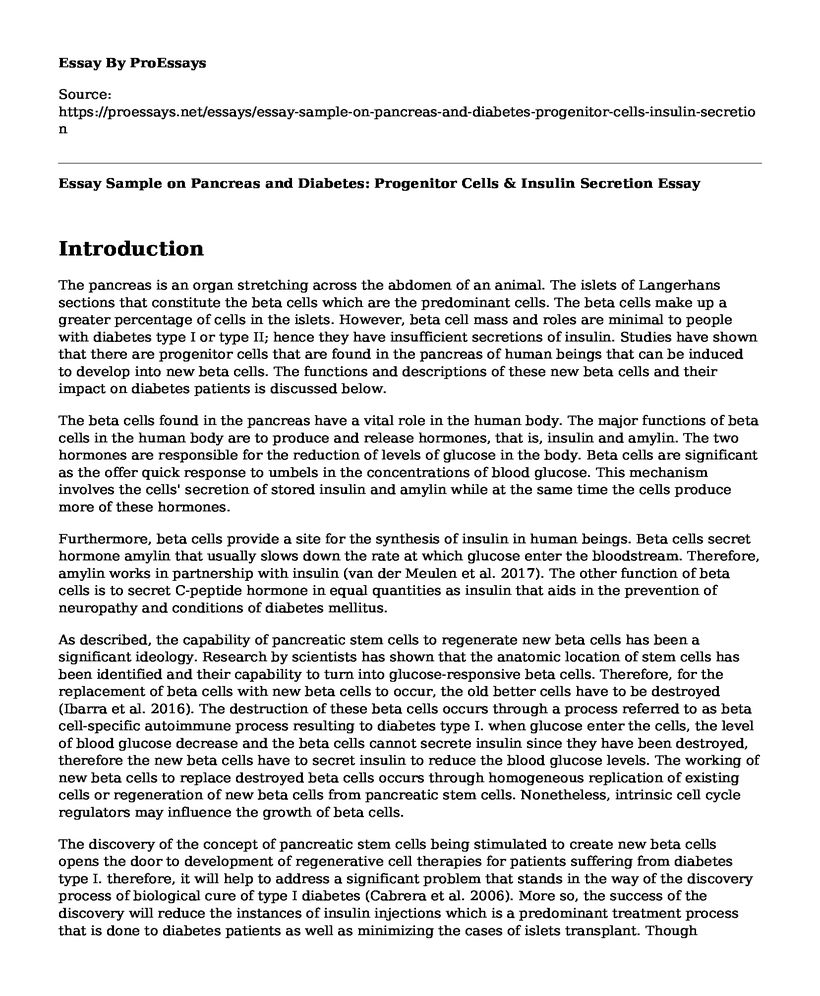Introduction
The pancreas is an organ stretching across the abdomen of an animal. The islets of Langerhans sections that constitute the beta cells which are the predominant cells. The beta cells make up a greater percentage of cells in the islets. However, beta cell mass and roles are minimal to people with diabetes type I or type II; hence they have insufficient secretions of insulin. Studies have shown that there are progenitor cells that are found in the pancreas of human beings that can be induced to develop into new beta cells. The functions and descriptions of these new beta cells and their impact on diabetes patients is discussed below.
The beta cells found in the pancreas have a vital role in the human body. The major functions of beta cells in the human body are to produce and release hormones, that is, insulin and amylin. The two hormones are responsible for the reduction of levels of glucose in the body. Beta cells are significant as the offer quick response to umbels in the concentrations of blood glucose. This mechanism involves the cells' secretion of stored insulin and amylin while at the same time the cells produce more of these hormones.
Furthermore, beta cells provide a site for the synthesis of insulin in human beings. Beta cells secret hormone amylin that usually slows down the rate at which glucose enter the bloodstream. Therefore, amylin works in partnership with insulin (van der Meulen et al. 2017). The other function of beta cells is to secret C-peptide hormone in equal quantities as insulin that aids in the prevention of neuropathy and conditions of diabetes mellitus.
As described, the capability of pancreatic stem cells to regenerate new beta cells has been a significant ideology. Research by scientists has shown that the anatomic location of stem cells has been identified and their capability to turn into glucose-responsive beta cells. Therefore, for the replacement of beta cells with new beta cells to occur, the old better cells have to be destroyed (Ibarra et al. 2016). The destruction of these beta cells occurs through a process referred to as beta cell-specific autoimmune process resulting to diabetes type I. when glucose enter the cells, the level of blood glucose decrease and the beta cells cannot secrete insulin since they have been destroyed, therefore the new beta cells have to secret insulin to reduce the blood glucose levels. The working of new beta cells to replace destroyed beta cells occurs through homogeneous replication of existing cells or regeneration of new beta cells from pancreatic stem cells. Nonetheless, intrinsic cell cycle regulators may influence the growth of beta cells.
The discovery of the concept of pancreatic stem cells being stimulated to create new beta cells opens the door to development of regenerative cell therapies for patients suffering from diabetes type I. therefore, it will help to address a significant problem that stands in the way of the discovery process of biological cure of type I diabetes (Cabrera et al. 2006). More so, the success of the discovery will reduce the instances of insulin injections which is a predominant treatment process that is done to diabetes patients as well as minimizing the cases of islets transplant. Though scientific research has been done and there are indications that glucose tolerance is achievable through stimulation of beta cell regeneration with gastrin administration based on conventional pharmacological therapy process the treatment is still unavailable to the public.
Conclusion
In conclusion, it is evident that effective scientific research is being done and it will be significant for the success of the process of beta cells stimulation to the patients living with diabetes. Therefore, the progression of various scientific research may enhance researchers to develop regenerative cell therapies for diabetes, both type I and potentially type II.
References
Cabrera, O., Berman, D. M., Kenyon, N. S., Ricordi, C., Berggren, P. O., & Caicedo, A. (2006). The unique cytoarchitecture of human pancreatic islets has implications for islet cell function. Proceedings of the National Academy of Sciences, 103(7), 2334-2339.
Ibarra Urizar, A., Friberg, J., Christensen, D. P., Lund Christensen, G., & Billestrup, N. (2016). Inflammatory cytokines stimulate bone morphogenetic protein-2 expression and release from pancreatic beta cells. Journal of Interferon & Cytokine Research, 36(1), 20-29.
van der Meulen, T., Mawla, A. M., DiGruccio, M. R., Adams, M. W., Nies, V., Dolleman, S., ... & Kaestner, K. H. (2017). Virgin beta cells persist throughout life at a neogenic niche within pancreatic islets. Cell Metabolism, 25(4), 911-926.
Cite this page
Essay Sample on Pancreas and Diabetes: Progenitor Cells & Insulin Secretion. (2023, Jan 03). Retrieved from https://proessays.net/essays/essay-sample-on-pancreas-and-diabetes-progenitor-cells-insulin-secretion
If you are the original author of this essay and no longer wish to have it published on the ProEssays website, please click below to request its removal:
- Implementation of Activities in the Implementation Plan for the Health Facility
- Case Study on Urinary Tract Infections
- Acute Myocardial Infarction Essay Example
- Attitudinal Issues Regarding Abortion - Essay Sample
- Ethical Conflicts in the Medical Field - Essay Sample
- Essay Sample on Child Abuse & Substance Abuse: 25% of Children at Risk
- Case Study Sample on Ethical Role of Nurses







